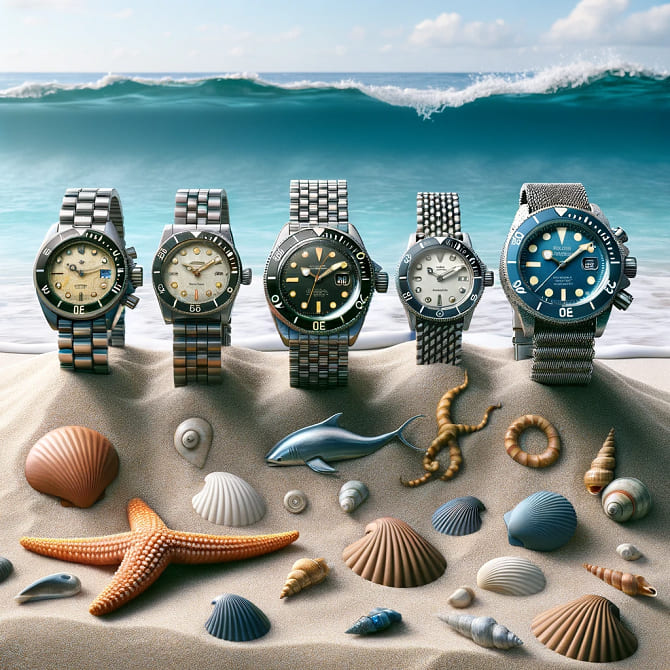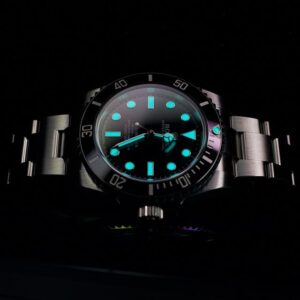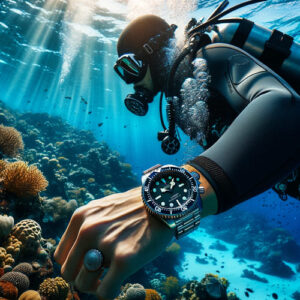The Evolution of Dive Watches: Navigating the Depths of Time

Dive watches have traversed a remarkable journey, evolving from essential instruments for underwater navigation to coveted symbols of style and sophistication. Initially crafted to meet the rigorous demands of saturation diving and underwater exploration, these timepieces were designed with paramount features such as water resistance, durability, and legibility. Renowned brands like Rolex, Omega, and Blancpain have been at the forefront of this transformation, continuously innovating to enhance the functionality and aesthetic appeal of dive watches. The Rolex Submariner, Omega Seamaster, and Blancpain Fifty Fathoms, in particular, have set benchmarks in the industry, blending seamless water-resistant technology with elegant design. Today, dive watches transcend their practical utility, embodying a taste for exploration and adventure. This chapter delves into the rich history of dive watches, exploring their evolution from indispensable tools for divers to iconic accessories that capture the imagination of modern audiences worldwide.
The Origins of Dive Watches
The journey of dive watches began in the early 20th century, driven by the nascent pursuit of underwater discovery and the consequent need for precise timekeeping beneath the sea. This period was characterized by the initial attempts to create watches that could resist water ingress, albeit with limited success. As technology and understanding advanced into the 1920s and 1930s, the watch industry witnessed the emergence of genuinely pioneering waterproof watches, like the Rolex Oyster case, which heralded a new era in dive watch technology. The role of these timepieces became increasingly significant during World War II, as military operations demanded watches that were not only water-resistant but also robust, reliable, and legible in the murky depths.
Here's a comparison of key features between early 20th-century dive watches and the pioneering waterproof watches of the 1920s-1930s:
| Feature | Early 20th-Century Dive Watches | 1920s-1930s Pioneering Waterproof Watches |
|---|---|---|
| Water Resistance | Basic resistance, prone to leaks | Advanced sealing, notably the Oyster case |
| Durability | Minimal protection against wear | Reinforced materials for greater durability |
| Legibility | Basic, often challenging to read | Enhanced with luminous materials for better visibility |
| Pressure Resistance | Limited to shallow dives | Improved design to withstand deeper dives |
| Innovation | Initial concepts of water resistance | Introduction of screw-down crowns and case backs |
This table illustrates the evolution from the rudimentary water-resistant features of early dive watches to the more sophisticated and durable designs of the 1920s and 1930s. This transformation was largely propelled by technological advancements and the pressing demands of wartime needs, setting the stage for the modern dive watches we know today.
Technological Innovations and Milestones
The 1950s-1960s can be aptly described as the golden era for dive watches, witnessing unparalleled technological advancements that set new benchmarks. This period saw the introduction of the Rolex Submariner, a breakthrough in water resistance and durability. Meanwhile, the Omega Seamaster pushed the boundaries further with significant advancements, enhancing underwater performance and reliability. Equally influential was the Blancpain Fifty Fathoms, which brought in the rotating bezel, a critical feature for tracking dive times accurately.
This era also marked the introduction of crucial breakthrough features. Rotating bezels became a standard for ensuring safety and precision underwater. Helium escape valves were introduced to protect watches during saturation diving, addressing the buildup of helium within the case, a concern for commercial divers engaging in deep-water activities. Moreover, the quest for increased water resistance led to innovations that allowed divers to explore new depths.
Acknowledging the evolving capabilities and complexities of dive watches, the ISO 6425 standard was established, defining the essential characteristics and performance standards of a true diver's watch. This standardization highlighted features such as durability, legibility, and water resistance as key benchmarks, ensuring dive watches could meet the rigorous demands of underwater exploration. These technological milestones not only enhanced the functionality of dive watches but also solidified their status as indispensable tools for divers worldwide.
Iconic Dive Watches That Marked History

In the riveting chronicle of dive watches, certain models stand as towering milestones, marking the evolution of these functional marvels into symbols of adventure and style. The Rolex Submariner, with its storied evolution, epitomizes the blend of durability and elegance. Its water-resistance capabilities, coupled with the Oyster case's ingenuity, crafted a legacy celebrated in both diving and horological circles. Then, there's the Omega Seamaster, whose legacy interweaves with the narrative of underwater exploration, boasting models like the Seamaster 300 and Planet Ocean, revered for their pioneering features and robustness. The Panerai models, designed for the Italian naval commandos, introduced innovations such as the Radiomir luminous material, enhancing legibility underwater. These watches not only contributed significantly to the dive watch genre but also cemented their status in popular culture, their appearances alongside iconic figures catapulting them into the realm of collectible vintage. This chapter navigates through the histories of these iconic timepieces, illustrating their monumental contributions to the tapestry of dive watch evolution.
Modern Advancements and Smart Dive Watches
The digital revolution ushered in an era of innovation within the dive watch segment, introducing smart dive watches that meld traditional craftsmanship with cutting-edge technology. This paradigm shift has empowered divers with digital and smart timepieces equipped with an array of advanced functionalities.
| Feature | Benefits |
|---|---|
| Digital Display | Enhances legibility underwater; offers precision |
| GPS Technology | Facilitates navigation and location tracking |
| Dive Computer Integration | Monitors depth, ascent rates, and no-decompression limits |
| Water Resistance | Maintains functionality at extreme depths |
| Titanium Cases | Offers durability with lightweight design |
These smart dive watches cater to the modern diver's needs while preserving the esteemed heritage of brands like Seiko, Rolex, and Omega. By integrating dive computer capabilities, titanium durability, and enhanced water resistance, these watches represent the zenith of dive watch evolution. Their appearances embrace the essence of their esteemed predecessors, while their functionalities leap towards the future, showcasing an exquisite blend of past and present in the realm of underwater exploration.
Environmental and Ethical Considerations
As we navigate through the evolution of dive watches, a pivotal chapter emerges, spotlighting the industry's commitment to environmental stewardship and ethical integrity. Leading brands like Rolex, Omega, and Panerai, revered for their precision and durability, are at the vanguard of integrating sustainable materials and eco-conscious manufacturing practices. This chapter unfolds how the dive watch industry, once focused solely on technological advancements, now pioneers in harmonizing craftsmanship with environmental and ethical responsibility.
Below is a table summarizing key sustainable initiatives adopted by the industry:
| Sustainability Effort | Impact |
|---|---|
| Use of Sustainable Materials | Utilizing recycled metals and biodegradable materials to craft dive watches, reducing environmental impact. |
| Solar-Powered Facilities | Adoption of renewable energy sources in manufacturing processes, decreasing carbon footprint. |
| Ethical Sourcing | Ensuring all materials (for water resistance, legibility, etc.) adhere to stringent ethical standards, protecting human rights and the environment. |
This approach not only minimizes the ecological footprints but also mirrors the contemporary values of responsibility towards our planet. Through focusing on sustainability and ethical manufacturing, the modern dive watch becomes not just a tool for exploring the depths but also a symbol of the wearer's commitment to preserving those very depths for future generations.
The Culture and Community Around Dive Watches
Dive watches have long transcended their utilitarian origins to become emblematic of adventure and exploration. This transition is deeply rooted in their history, dating back to when pioneers first defied the depths, wrist adorned with timepieces engineered for the abyss. As these watches evolved, so did a vibrant community hell-bent on embracing the spirit of discovery they represent. Today, forums and social media platforms are bustling hubs, where enthusiasts and collectors alike converge, sharing insights, experiences, and the thrill of the hunt. These digital arenas have become the bedrock of the dive watch culture, further enriching its narrative and shaping its legacy. Amidst this, the vintage market thrives, driven by a collective yearning to own a piece of history—whether it's a Rolex Submariner, an Omega Seamaster, or a Blancpain Fifty Fathoms—each watch a token of a bygone era, yet forever a symbol of mankind's insatiable taste for exploration.
The Future of Dive Watches
In summary, a multitude of factors ranging from battery depletion, mechanical wear, magnetic interference, physical damage, water exposure, to everyday wear and tear can lead to your watch ceasing its operations. Each of these issues elucidates the intricate balance of craftsmanship and care that timepieces demand. As watch owners, proactive measures such as regular maintenance, understanding your watch's limitations, and adopting protective habits can significantly extend the life of your cherished accessory. For instances that transcend simple battery replacements or require intricate attention, such as dealing with mechanical failures or water damage, it's imperative to seek the expertise of professional watchmakers. Their proficiency not only guarantees the restoration of your watch's functionality but also preserves its legacy. Regularly servicing your watch, akin to a ritual, ensures that this timeless companion continues to mark the moments of your life with impeccable precision and elegance.
Conclusion
The evolution of dive watches encapsulates a remarkable journey from practical underwater tools to emblems of prestige and adventure. What began as indispensable instruments for divers, equipped with necessary features like water resistance and legibility, has transformed into stylish accessories admired by watch enthusiasts and fashion-conscious individuals alike. Iconic models such as the Rolex Submariner, Omega Seamaster, and Blancpain Fifty Fathoms have not only set the standard in the dive watch industry but have also established a legacy celebrated across generations. Their development reflects a continual pursuit of technological innovation, marrying function with elegance in a rapidly evolving world. Despite the digital age introducing smart dive watches, the allure of mechanical dive watches remains undiminished, proving that their legacy endures beyond mere timekeeping. As we look to the future, it's clear that dive watches will continue to inspire, combining the spirit of exploration with a taste for refined aesthetics, navigating the depths of both the ocean and time with unwavering elegance.
